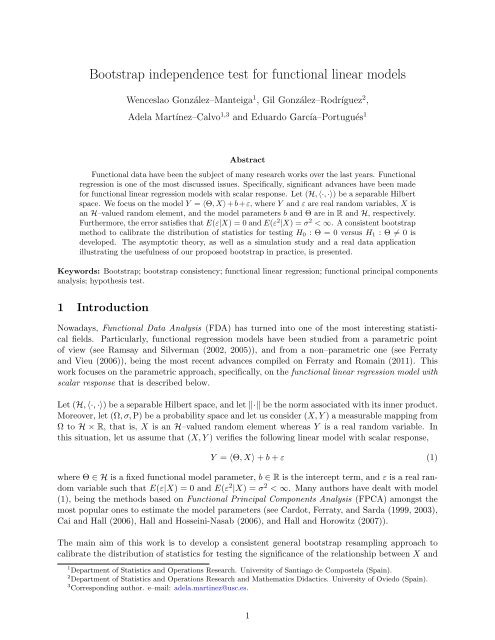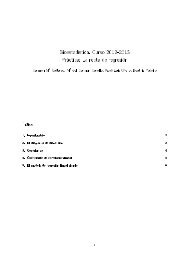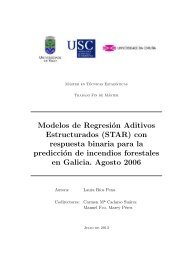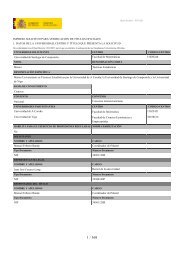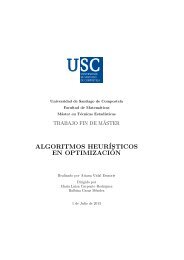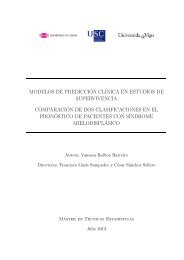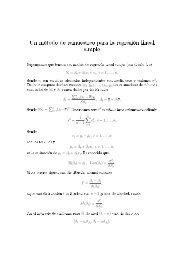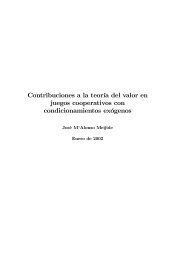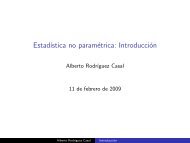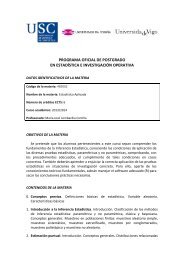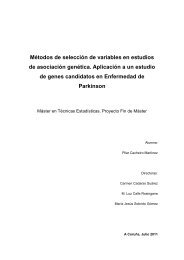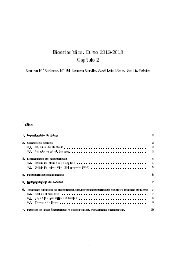Bootstrap independence test for functional linear models
Bootstrap independence test for functional linear models
Bootstrap independence test for functional linear models
Create successful ePaper yourself
Turn your PDF publications into a flip-book with our unique Google optimized e-Paper software.
<strong>Bootstrap</strong> <strong>independence</strong> <strong>test</strong> <strong>for</strong> <strong>functional</strong> <strong>linear</strong> <strong>models</strong>Wenceslao González–Manteiga 1 , Gil González–Rodríguez 2 ,Adela Martínez–Calvo 1,3 and Eduardo García–Portugués 1AbstractFunctional data have been the subject of many research works over the last years. Functionalregression is one of the most discussed issues. Specifically, significant advances have been made<strong>for</strong> <strong>functional</strong> <strong>linear</strong> regression <strong>models</strong> with scalar response. Let (H, 〈·, ·〉) be a separable Hilbertspace. We focus on the model Y = 〈Θ, X〉 + b + ε, where Y and ε are real random variables, X isan H–valued random element, and the model parameters b and Θ are in R and H, respectively.Furthermore, the error satisfies that E(ε|X) = 0 and E(ε 2 |X) = σ 2 < ∞. A consistent bootstrapmethod to calibrate the distribution of statistics <strong>for</strong> <strong>test</strong>ing H 0 : Θ = 0 versus H 1 : Θ ≠ 0 isdeveloped. The asymptotic theory, as well as a simulation study and a real data applicationillustrating the usefulness of our proposed bootstrap in practice, is presented.Keywords: <strong>Bootstrap</strong>; bootstrap consistency; <strong>functional</strong> <strong>linear</strong> regression; <strong>functional</strong> principal componentsanalysis; hypothesis <strong>test</strong>.1 IntroductionNowadays, Functional Data Analysis (FDA) has turned into one of the most interesting statisticalfields. Particularly, <strong>functional</strong> regression <strong>models</strong> have been studied from a parametric pointof view (see Ramsay and Silverman (2002, 2005)), and from a non–parametric one (see Ferratyand Vieu (2006)), being the most recent advances compiled on Ferraty and Romain (2011). Thiswork focuses on the parametric approach, specifically, on the <strong>functional</strong> <strong>linear</strong> regression model withscalar response that is described below.Let (H, 〈·, ·〉) be a separable Hilbert space, and let ‖·‖ be the norm associated with its inner product.Moreover, let (Ω, σ, P) be a probability space and let us consider (X, Y ) a measurable mapping fromΩ to H × R, that is, X is an H–valued random element whereas Y is a real random variable. Inthis situation, let us assume that (X, Y ) verifies the following <strong>linear</strong> model with scalar response,Y = 〈Θ, X〉 + b + ε (1)where Θ ∈ H is a fixed <strong>functional</strong> model parameter, b ∈ R is the intercept term, and ε is a real randomvariable such that E(ε|X) = 0 and E(ε 2 |X) = σ 2 < ∞. Many authors have dealt with model(1), being the methods based on Functional Principal Components Analysis (FPCA) amongst themost popular ones to estimate the model parameters (see Cardot, Ferraty, and Sarda (1999, 2003),Cai and Hall (2006), Hall and Hosseini-Nasab (2006), and Hall and Horowitz (2007)).The main aim of this work is to develop a consistent general bootstrap resampling approach tocalibrate the distribution of statistics <strong>for</strong> <strong>test</strong>ing the significance of the relationship between X and1 Department of Statistics and Operations Research. University of Santiago de Compostela (Spain).2 Department of Statistics and Operations Research and Mathematics Didactics. University of Oviedo (Spain).3 Corresponding author. e–mail: adela.martinez@usc.es.1
Y , that is, <strong>for</strong> <strong>test</strong>ing H 0 : Θ = 0 versus H 1 : Θ ≠ 0, on the basis of a simple random sample{(X i , Y i )} n i=1 drawn from (X, Y ). The bootstrap techniques will become an alternative useful toolwhen the asymptotics of <strong>test</strong> statistics are unknown or when they are inaccurate due to small samplesize.Since its introduction by Efron (1979), it is well–known that the bootstrap method results in anew distribution approximation which can be applied to a large number of situations, such as thecalibration of pivotal quantities in the finite dimensional context (see Bickel and Freedman (1981),and Singh (1981)). As far as multivariate regression <strong>models</strong> are concerned, bootstrap validity <strong>for</strong><strong>linear</strong> and non–parametric <strong>models</strong> was also stated in literature (see Freedman (1981), and Cao-Abad (1991)). Currently, the application of bootstrap to the <strong>functional</strong> field has been successfullystarted. For instance, Cuevas, Febrero, and Fraiman (2006) have proposed bootstrap confidencebands <strong>for</strong> several <strong>functional</strong> estimators such as the sample and the trimmed <strong>functional</strong> means. In theregression context, Ferraty, Van Keilegom, and Vieu (2010), and González-Manteiga and Martínez-Calvo (2011) have shown the validity of the bootstrap in the estimation of non–parametric <strong>functional</strong>regression and <strong>functional</strong> <strong>linear</strong> model, respectively, when the response is scalar. They have alsoproposed pointwise confidence intervals <strong>for</strong> the regression operator involved in each case. In addition,the asymptotic validity of a componentwise bootstrap procedure has been proved by Ferraty,Van Keilegom, and Vieu (2012) when a non–parametric regression is considered and both responseand regressor are <strong>functional</strong>.<strong>Bootstrap</strong> techniques can also be very helpful <strong>for</strong> <strong>test</strong>ing purposes, since they can be used in orderto approximate the distribution of the statistic under the null hypothesis H 0 . For example, Cuevas,Febrero, and Fraiman (2004) have developed a sort of parametric bootstrap to obtain quantiles<strong>for</strong> an ANOVA <strong>test</strong>, and González-Rodríguez, Colubi, and Gil (2012) have proved the validity ofa residual bootstrap in that context. Hall and Vial (2006) and, more recently, Bathia, Yao, andZiegelmann (2010) have studied the finite dimensionality of <strong>functional</strong> data using a bootstrap approximation<strong>for</strong> independent and dependent data, respectively.As was indicated previously, <strong>test</strong>ing the lack of dependence between X and Y is our goal. Thisissue has stirred up a great interest during the last years due to its practical applications in the<strong>functional</strong> context. For instance, Kokoszka, Maslova, Sojka, and Zhu (2008) proposed a <strong>test</strong> <strong>for</strong> lackof dependence in the <strong>functional</strong> <strong>linear</strong> model with <strong>functional</strong> response which was applied to magnetometercurves consisting of minute–by–minute records of the horizontal intensity of the magneticfield measured at observatories located at different latitude. The aim was to analyse if the high–latitude records had a <strong>linear</strong> effect on the mid– or low–latitude records. On the other hand, Cardot,Prchal, and Sarda (2007) presented a statistical procedure to check if a real–valued covariate has aneffect on a <strong>functional</strong> response in a nonparametric regression context, using this methodology <strong>for</strong> astudy of atmospheric radiation. In this case, the dataset were radiation profiles curves measured ata random time and the authors <strong>test</strong>ed if the radiation profiles changed along the time.Regarding the regression model (1), <strong>test</strong>ing the significance of the relationship between a <strong>functional</strong>covariate and a scalar response has been the subject of recent contributions, and asymptotic approaches<strong>for</strong> this problem can be found in Cardot, Ferraty, Mas, and Sarda (2003) or Kokoszka,Maslova, Sojka, and Zhu (2008). The methods presented in these two works are mainly based onthe calibration of the statistics distribution by using asymptotic distribution approximations. Incontrast, we propose a consistent bootstrap calibration in order to approximate the statistics distribution.For that, we firstly introduce in Section 2 some notation and basic concepts about theregression model (1), the asymptotic theory <strong>for</strong> the <strong>test</strong>ing procedure, and the consistency of thebootstrap techniques that we propose. In Section 3, the bootstrap calibration is presented as analternative to the asymptotic theory previously exposed. Then, Section 4 is devoted to the empirical2
esults. A simulation study and a real data application allow us to show the per<strong>for</strong>mance of ourbootstrap methodology in comparison with the asymptotic approach. Finally, some conclusions aresummarized in Section 5.2 Asymptotic theory and bootstrapLet us consider the model (1) given in the previous Section 1. In this framework, the regressionfunction, denoted by m, is given bym(x) = E(Y |X = x) = 〈Θ, x〉 + b <strong>for</strong> all x ∈ H.The aim is to develop correct and consistent bootstrap techniques <strong>for</strong> <strong>test</strong>ing{H0 : Θ = 0H 1 : Θ ≠ 0on the basis of a random sample {(X i , Y i )} n i=1 of independent and identically distributed randomelements with the same distribution as (X, Y ). That is, our objective is to check whether X and Yare <strong>linear</strong>ly independent (H 0 ) or not (H 1 ).Next, we expose briefly some technical background required to develop the theoretical results presentedthroughout the section.2.1 Some backgroundRiesz Representation Theorem ensures that the <strong>functional</strong> <strong>linear</strong> model with scalar response can behandled theoretically within the considered framework. Specifically, let H be the separable Hilbertspace of square Lebesgue integrable functions on a given compact set C ⊂ R, denoted by L 2 (C, λ),with the usual inner product and the associated norm ‖ · ‖. The <strong>functional</strong> <strong>linear</strong> model with scalarresponse between a random function X and a real random variable Y is defined as(2)Y = Φ(X) + ɛ, (3)where Φ is a continuous <strong>linear</strong> operator (that is, Φ ∈ H ′ , being H ′ the dual space of H with norm‖ · ‖ ′ ), and ɛ is a real random variable with finite variance and independent of X. In virtue of RieszRepresentation Theorem H and H ′ are isometrically identified, in such a way that <strong>for</strong> any Φ ∈ H ′there exists a unique Θ ∈ H so that ‖Θ‖ = ‖Φ‖ ′ and Φ(h) = 〈Θ, h〉 <strong>for</strong> all h ∈ H. Consequently,the model presented in equation (3) is just a particular case of the one considered in (1).Previous works regarding <strong>functional</strong> <strong>linear</strong> <strong>models</strong> assume b = 0 (see Cardot, Ferraty, Mas, andSarda (2003), and Kokoszka, Maslova, Sojka, and Zhu (2008)). Of course, the intercept term canbe embedded in the variable counterpart of the model as in the multivariate case as follows. LetH e be the product space H × R with the corresponding inner product 〈·, ·〉 e , and define X ′ = (X, 1)and Θ ′ = (Θ, b) ∈ H e . Then the model considered in (1) can be rewritten as Y = 〈Θ ′ , X ′ 〉 e + ε(and consequently X ′ cannot be assumed to be centered). Nevertheless, in the context of the <strong>linear</strong><strong>independence</strong> <strong>test</strong>, the aim is to check if Θ = 0 or not, and this is not equivalent to checking whetherΘ ′ = 0 or not. In addition, in practice the intercept term b cannot be assumed to be equal to 0. Thus,in order to avoid any kind of confusion, in this paper the intercept term b has been written explicitly.In the same way, in the above mentioned papers, the random element X is assumed to be centered.Although, in many cases, the asymptotic distribution of the proposed statistics does not change if{X i } n i=1 is replaced by the dependent sample {X i − X} n i=1 , the situation with the bootstrap versionof the statistics could be quite different. In fact, as it will be shown afterwards, different bootstrapstatistics could be considered when this replacement is done. Hence, <strong>for</strong> the developments in thissection, it will not be assumed that the X variable is centered.3
2.2 Linear <strong>independence</strong> <strong>test</strong>Given a generic H–valued random element H such that E(‖H‖ 2 ) < ∞, its associated covarianceoperator Γ H is defined as the operator Γ H : H → HΓ H (h) = E (〈H − µ H , h〉(H − µ H )) = E (〈H, h〉H) − 〈µ H , h〉µ H ,<strong>for</strong> all h ∈ H, where µ H ∈ H denotes the expected value of H. From now on, it will be assumedthat E(‖X‖ 2 ) < ∞, and thus, as a consequence of Hölder’s inequality, E(Y 2 ) < ∞. Wheneverthere is no possible confusion, Γ X will be abbreviated as Γ. It is well–known that Γ is a nuclearand self–adjoint operator. In particular, it is a compact operator of trace class and thus, in virtueof the Spectral Theorem Decomposition, there is an orthonormal basis of H, {v j } j∈N , consisting oneigenvectors of Γ with corresponding eigenvalues {λ j } j∈N , that is, Γ(v j ) = λ j v j <strong>for</strong> all j ∈ N. Asusual, the eigenvalues are assumed to be arranged in decreasing order (λ 1 ≥ λ 2 ≥ . . .). Since theoperator Γ is symmetric and non–negative definite, then the eigenvalues are non–negative.In a similar way, let us consider the cross–covariance operator ∆ : H → R between X and Y givenby∆(h) = E (〈X − µ X , h〉(Y − µ Y )) = E (〈X, h〉Y ) − 〈µ X , h〉µ Y ,<strong>for</strong> all h ∈ H, where µ Y ∈ R denotes the expected value of Y . Of course, ∆ ∈ H ′ and the followingrelation between the considered operators and the regression parameter Θ is satisfied∆(·) = 〈Γ(·), Θ〉. (4)The Hilbert space H can be expressed as the direct sum of the two orthogonal subspaces inducedby the self–adjoint operator Γ: the kernel or null space of Γ, N (Γ), and the closure of the image orrange of Γ, R(Γ). Thus, Θ is determined uniquely by Θ = Θ 1 +Θ 2 with Θ 1 ∈ N (Γ) and Θ 2 ∈ R(Γ).As Θ 1 ∈ N (Γ), it is easy to check that V ar(〈X, Θ 1 〉) = 0 and, consequently, the model introducedin (1) can be expressed asY = 〈Θ 2 , X〉 + 〈Θ 1 , µ X 〉 + b + ε.There<strong>for</strong>e, it is not possible to distinguish between the term 〈Θ 1 , µ X 〉 and the intercept term b,and consequently it is not possible to check whether Θ 1 = 0 or not. Taking this into account, thehypothesis <strong>test</strong> will be restricted to check{H0 : Θ 2 = 0(5)H 1 : Θ 2 ≠ 0on the basis of the available sample in<strong>for</strong>mation.Note that in this case, according to the relation between the operators and the regression parametershown in (4), Θ 2 = 0 if, and only if, ∆(h) = 0 <strong>for</strong> all h ∈ H. Consequently, the hypothesis <strong>test</strong> in(5) is equivalent to{H0 : ‖∆‖ ′ = 0H 1 : ‖∆‖ ′ (6)≠ 0Remark 1. It should be recalled that, in previous works µ X is assumed to be equal 0. Thus,the preceding reasoning leads to the fact that Θ 1 cannot be estimated based on the in<strong>for</strong>mationprovided by X (see, <strong>for</strong> instance, Cardot, Ferraty, Mas, and Sarda (2003)). Consequently thehypothesis <strong>test</strong>ing is also restricted to the one in the preceding equations. In addition in Cardot,Ferraty, Mas, and Sarda (2003), it is also assumed <strong>for</strong> technical reasons that R(Γ) is an infinite–dimensional space. On the contrary, this restriction is not imposed in the study here developed.4
Remark 2. Note that another usual assumption is that the intercept term vanishes. Although thisis not common in most of situations, it should be noted that if b = 0 and X is not assumed to becentered (as in this work), then an interesting possibility appears: to check whether Θ 1 = 0 or notby checking the nullity of the intercept term of the model, and thus to check the original hypothesis<strong>test</strong>ing in (2). This open problem cannot be solved with the methodology employed in the currentpaper (or in the previous ones) because the idea is based on checking (6), which is equivalent to therestricted <strong>test</strong> (5) but not to the unrestricted one in (2).2.3 Testing procedure and asymptotic theoryAccording to the relation between ‖ · ‖ ′ and ‖ · ‖, the dual norm of ∆ ∈ H ′ can be expressedequivalently in terms of the H–valued random element (X − µ X )(Y − µ Y ) as follows‖∆‖ ′ = ‖〈E ((X − µ X )(Y − µ Y )) , ·〉‖ ′ = ‖E ((X − µ X )(Y − µ Y )) ‖.Thus, based on an i.i.d. sample {(X i , Y i )} n i=1drawn from (X, Y ),D = ‖E ((X − µ X )(Y − µ Y )) ‖ = ‖T ‖can be estimated in a natural way by means of its empirical counterpart D n = ‖T n ‖, where T n isthe H–valued random element given byT n = 1 nn∑(X i − X)(Y i − Y ),i=1where X and Y denote as usual the corresponding sample means. The next theorem establishessome basic properties of T n .Theorem 1. Assuming that (1) holds with E(ε) = 0, E(ε 2 ) = σ 2 < ∞ and E(‖X‖ 4 ) < ∞, then1. E(T n ) = E ((X − µ X )(Y − µ Y )) (n − 1)/n2. T n converges a.s.–P to E ((X − µ X )(Y − µ Y )) as n → ∞3. √ n (T n − E ((X − µ X )(Y − µ Y ))) converges in law, as n → ∞, to a centered Gaussian elementZ in H with covariance operatorΓ Z (·) = σ 2 Γ(·) + E ( (X − µ X )〈X − µ X , ·〉〈X − µ X , Θ〉 2) .Proof. Since T n can be equivalently expressed asT n = 1 nn∑(X i − µ X )(Y i − µ Y ) + (X − µ X )(Y − µ Y ),i=1it is straight<strong>for</strong>ward to check item 1. The a.s.–P convergence is a direct application of the SLLN<strong>for</strong> separable Hilbert–valued random elements.On the other hand, given that E(‖(X − µ X )(Y − µ Y )‖ 2 ) < ∞, the convergence in law can bededuced by applying the CLT <strong>for</strong> separable Hilbert–valued random elements (see, <strong>for</strong> instance, Lahaand Rohatgi (1979)) together with Slutsky’s Theorem. The concrete expression of the operatorΓ Z , that is, Γ Z = Γ (X−µX )(Y −µ Y ) = Γ (X−µX )ε + Γ (X−µX )〈X−µ X ,Θ〉, can be obtained by simplecomputations.In order to simplify the notation, from now on, given any H–valued random element H withE(‖H‖ 2 ) < ∞, Z H will denote a centered Gaussian element in H with covariance operator Γ H .5
Corollary 1. Under the conditions of Theorem 1, if the null hypothesis H 0 : ‖∆‖ ′ = 0 is satisfied,then √ nT n converges in law to Z (X−µX )ε (with covariance operator σ 2 Γ), and consequently, ‖ √ nT n ‖converges in law to ‖Z (X−µX )ε‖.In contrast to Theorem 1 in Cardot, Ferraty, Mas, and Sarda (2003), the result in Corollary 1 isestablished directly on the Hilbert space H instead of on its dual space. In addition, no assumptionof centered X random elements or null intercept term is necessary. Nevertheless these two assumptionscould be easily removed in that paper in order to establish a dual result of Corollary 1.Furthermore, in view of Corollary 1, the asymptotic null distribution of ‖ √ nT n ‖ is not explicitlyknown. This is the reason why no further research on how to use in practice this statistic (or itsdual one) <strong>for</strong> checking if Θ 2 equals 0 is carried out in Cardot, Ferraty, Mas, and Sarda (2003).Instead, an alternative statistic that is used in the simulation section <strong>for</strong> comparative purposes isconsidered. Nevertheless, it is still possible to use ‖ √ nT n ‖ as a core statistic in order to solve this<strong>test</strong> in practice by means of bootstrap techniques.One natural way of using the asymptotic result of Corollary 1 <strong>for</strong> solving the <strong>test</strong> under studyis as follows. Consider a consistent (at least under H 0 ) estimator σn 2 of σ 2 (<strong>for</strong> instance, thesample variance of Y could be used, or perhaps the one introduced by Cardot, Ferraty, Mas, andSarda (2003), provided that its theoretical behavior is analyzed). Then, according to Slutsky’sTheorem ‖ √ nT n ‖/σ n converges in law under H 0 to the norm of Z X . As its covariance operator Γ isunknown, it can be approximated by the empirical one Γ n . And thus, ‖Z X ‖ can be approximatedby ‖Z n ‖, being Z n a centered Gaussian element in H with covariance operator Γ n . Of course, thedistribution of ‖Z n ‖ is still difficult to compute directly, nevertheless one can make use of the CLTand approximate its distribution by Monte Carlo method by the distribution of1m∑(Xi ∗ − X)∥m∥i=1<strong>for</strong> a large value of m, being {Xi ∗}m i=1 i.i.d. random elements chosen at random from the fixedpopulation (X 1 , . . . , X n ). Obviously, this method is a precursor of the bootstrap procedures.In order to complete the asymptotic study of the statistic ‖ √ nT n ‖, its behavior under local alternativesis going to be analyzed. To this purpose, let us consider Θ ∈ H so that ‖Θ 2 ‖ > 0, and givenδ n > 0 consider the modified random sampleY ni= 〈X i , δ n√ nΘ〉 + b + ε i ,<strong>for</strong> all i ∈ {1, . . . , n}. Then, the null hypothesis is not verified. However, if δ n / √ n → 0, then‖(δ n / √ n)Θ‖ → 0, that is, H 0 is approached with “speed” δ n / √ n. In these conditions,E ( (X i − µ Xi )(Y ni− µ Y ni) ) = δ n√ ∆(Θ), nand thus the following theorem that establishes the behavior of the statistic under the consideredlocal alternatives can be easily deduced.Theorem 2. Under the conditions of Theorem 1 and with the above notation, if δ n → ∞ andδ n / √ n → 0 as n → ∞ then(∥ ∥∥∥∥1n∑ (P √n Xi − X ) ( )Yin − Y n)∥ ∥ ∥∥∥≤ t → 0as n → ∞, <strong>for</strong> all t ∈ R.i=16
2.4 <strong>Bootstrap</strong> proceduresThe difficulty of using the previously proposed statistic to solve the hypothesis <strong>test</strong> by means ofasymptotic procedures suggests the development of appropriated bootstrap techniques. The asymptoticconsistency of a bootstrap approach is guaranteed if the associated bootstrap statistic convergesin law to a non–degenerated distribution irrespectively of H 0 being satisfied or not. In addition, inorder to ensure its asymptotic correctness, this limit distribution must coincide with the asymptoticone of the <strong>test</strong>ing statistic provided that H 0 holds.Consequently, the asymptotic limit established in Corollary 1 plays a fundamental role <strong>for</strong> definingappropriate bootstrap statistics. In this way, recall that1√ nn∑ ((Xi − X )( Y i − Y ) − E ( (X − µ X )(Y − µ Y ) ))i=1converges in law to Z (X−µX )(Y −µ Y ), irrespectively of H 0 being satisfied or not and, in addition, ifH 0 is satisfied then Γ (X−µX )(Y −µ Y ) = σ 2 Γ. Thus, this is a natural statistic to be mimicked by abootstrap one. Note that,(1nn∑ (Yi − Y ) ) (2 1n∑ ( ) ) √ Xi − µ X , (7)ni=1converges in law to (σ 2 +E(〈X −µ X , Θ〉 2 )Z X , whose covariance operator is (σ 2 +E(〈X −µ X , Θ〉 2 )Γ.Particularly, when H 0 is satisfied, this operator reduces again to σ 2 Γ. Consequently, another possibilityconsists in mimicking this second statistic by means of a bootstrap one, improving theapproximation suggested in the previous subsection. Note that the left term in the product inequation (7) could be substituted by any other estimator under H 0 of σ 2 that converges to a finiteconstant if H 0 does not hold. Anyway, this second approximation could lead to worst results underthe null hypothesis, because the possible dependency between X and ε is lost (as the resamplewould focus only on the X in<strong>for</strong>mation).Two possibilities <strong>for</strong> mimicking the statistics which were above–mentioned are going to be explored,namely a “naive” paired bootstrap and a “wild” bootstrap approach. In order to achieve this goal, let{(Xi ∗, Y i ∗)}ni=1 be a collection of i.i.d. random elements drawn at random from (X 1, Y 1 ), . . . , (X n , Y n ),and let us consider the following “naive” paired bootstrap statisticT N∗n = 1 √ nn∑i=1i=1((X∗i − X ∗)( Y ∗i − Y ∗) − ( X i − X )( Y i − Y )) .− Y ∗ ) 2 , the empir-In addition, let us consider σn 2 = (1/n) ∑ ni=1 (Y i − Y ) 2 and σn∗2 = (1/n) ∑ nical estimator of σY2 under H 0 and its corresponding bootstrap version.i=1 (Y i∗The asymptotic behavior of the “naive” bootstrap statistic will be analyzed through some resultson bootstrapping general empirical measures obtained by Giné and Zinn (1990). It should be notedthat the bootstrap results in that paper refer to empirical process indexed by a class of functions F,that particularly extend to the bootstrap about the mean in separable Banach (and thus Hilbert)spaces. In order to establish this connection, it is enough to chooseF = {f ∈ H ′ |‖f‖ ′ ≤ 1}(see Giné (1997) and Kosorok (2008), <strong>for</strong> a general overview of indexed empirical process). F isimage admissible Suslin (considering the weak topology). In addition, F (h) = sup f∈F |f(h)| = ‖h‖7
<strong>for</strong> all h ∈ H and thus E(F 2 (X)) = E(‖X‖ 2 ) < ∞.Consider the bounded and <strong>linear</strong> (so continuous) operator δ from H to l ∞ (F) given by δ(h)(f) =δ h (f) = f(h) <strong>for</strong> all h ∈ H and all f ∈ F and denote by R(δ) ⊂ l ∞ (F) its range. As ‖δ(h)‖ = ‖h‖<strong>for</strong> all h ∈ H then, there exists δ −1 : R(δ) → H, so that δ −1 is continuous. In addition, as R(δ)is closed, Dugundji Theorem allows us to consider a continuous extension δ −1 : l ∞ (F) → H (see<strong>for</strong> instance Kosorok (2008), Lemma 6.16 and Theorem 10.9). Thus, following the typical empiricalprocess notation, the empirical process (1/ √ n) ∑ ni=1 (δ X i− P) indexed in F is directly connectedwith (1/ √ n) ∑ ni=1 (X i − E(X)) by means of the continuous mapping δ −1 and vice–versa.Some consequences of this <strong>for</strong>mulation applied to the work developed by Giné and Zinn (1990) leadto the results collected in following lemma.Lemma 1. Let ξ be a measurable mapping from a probabilistic space denoted by (Ω, σ, P ) to aseparable Hilbert space (H, 〈·, ·〉) with corresponding norm ‖ · ‖ so that E(‖ξ‖ 2 ) < ∞. Let {ξ i } n i=1 bea sequence of i.i.d. random elements with the same distribution as ξ, and let {ξi ∗}n i=1 be i.i.d. from{ξ i } n i=1 . Then1. √ n(ξ ∗ − ξ) converges in law to Z ξ a.s.–P2. ξ ∗ converges in probability to E(ξ) a.s.–P3. ‖ξ ∗ ‖ 2 converges in probability to E(‖ξ‖ 2 ) a.s.–PProof. To prove item 1 note that the CLT <strong>for</strong> separable Hilbert–valued random elements (see,<strong>for</strong> instance, Laha and Rohatgi (1979)) together with the Continuous Mapping Theorem appliedto δ guarantees that F ∈ CTL(P ). Thus, Theorem 2.4 of Giné and Zinn (1990) ensures thatn 1/2 ( ˆP n (w)−P n (w)) converges in law to a Gaussian process on F, G = δ(Z ξ ) a.s.–P . Consequently,by applying again the Continuous Mapping Theorem √ n(ξ ∗ − ξ) = δ −1 (n 1/2 ( ˆP n (w) − P n (w))) convergesin law to Z ξ = δ −1 (G).Items 2 and 3 can be checked in a similar way by applying Theorem 2.6 of Giné and Zinn (1990).Note that item 1 is also a direct consequence of Remark 2.5 of Giné and Zinn (1990); neverthelessit was proven based on Theorem 2.4 to illustrate the technique.The following theorem establishes the asymptotic consistency and correctness of the “naive” bootstrapapproach.Theorem 3. Under the conditions of Theorem 1, we have that √ nTnN∗ converges in law toZ (X−µX )(Y −µ Y ) a.s.–P . In addition, σn ∗2 converges in probability to σY 2a.s.–P .= σ2 + E(〈X − µ X , Θ〉 2 )Proof. First of all consider the bootstrap statisticS ∗ n = 1 √ nn∑i=1( (X∗i − µ X)(Y∗i − µ Y)−(X − µX)(Y − µY) )and note that { ( Xi ∗ − µ )X)(Y∗i − µ Y }ni=1 are i.i.d. H–valued random elements chosen at randomfrom the “bootstrap population” { ( )( )X i − µ X Yi − µ Y }ni=1 . Then, item 1 in Lemma 1 guaranteesthat Sn ∗ converges in law to Z (X−µX )(Y −µ Y ) a.s.–P .On the other hand, Sn ∗ equals √ nTnN∗ plus the following terms1√ n√ n(X ∗ − X) √ n(Y ∗ − Y ) + √ n(X ∗ − X)(Y ∗ − µ Y ) + (X ∗ − µ X ) √ n(Y ∗ − Y ).8
Items 1 and 2 in Lemma 1, together with Slutsky’s Theorem, ensure that these three terms convergein probability to 0 a.s.–P , and consequently the convergence in law stated in the theorem is proven.Finally, the convergence of σ ∗2n holds in virtue of items 2 and 3 in Lemma 1.The “naive” bootstrap approach is described in the following algorithm.Algorithm 1 (Naive <strong>Bootstrap</strong>).Step 1. Compute the value of the statistic T n (or the value T n /σ n ).Step 2. Draw {(Xi ∗, Y i ∗)}ni=1 , a sequence of i.i.d. random elements chosen at random from theinitial sample (X 1 , Y 1 ), . . . , (X n , Y n ), and compute a n = ‖TnN∗ ‖ (or b n = ‖TnN∗ ‖/σn).∗Step 3. Repeat Step 2 a large number of times B ∈ N in order to obtain a sequence of values{a l n} B l=1 (or {bl n} B l=1 ).Step 4. Approximate the p–value of the <strong>test</strong> by the proportion of values in {a l n} B l=1greater than orequal to ‖T n ‖ (or by the proportion of values in {b l n} B l=1 greater than or equal to ‖T n‖/σ n )Analogously, let {ε ∗ i }n i=1 be i.i.d. centered real random variables so that E( (ε ∗ i )2) = 1 and∫ ∞0 (P (|ε 1| > t) 1/2 ) < ∞ (to guarantee this last assumption, it is enough that E ( (ε ∗ i )d) < ∞ <strong>for</strong>certain d > 2), and consider the “wild” bootstrap statisticT W ∗n = 1 √ nn∑ (Xi − X )( Y i − Y ) ε ∗ i .i=1In order to analyze the asymptotic behavior of the “wild” bootstrap statistic, the following lemmawill be fundamental. It is a particularization of a result due to Ledoux, Talagrand and Zinn (cf.Giné and Zinn (1990), and Ledoux and Talagrand (1988)). See also the Multiplier Central LimitTheorem in Kosorok (2008) <strong>for</strong> the empirical process indexed by a class of measurable functionscounterpart.Lemma 2. Let ξ be a measurable mapping from a probabilistic space denoted by (Ω, σ, P ) to aseparable Hilbert space (H, 〈·, ·〉) with corresponding norm ‖ · ‖ so that E(‖ξ‖ 2 ) < ∞. Let {ξ i } n i=1 bea sequence of i.i.d. random elements with the same distribution as ξ, and let {W i } n i=1 be a sequenceof i.i.d. random variables (in the same probability space and independent of {ξ i } n i=1 ) with E(W i) = 0and ∫ ∞0 (P (|W 1| > t) 1/2 ) < ∞, then the following are equivalent1. E(‖ξ‖ 2 ) < ∞ (and consequently √ n(ξ − E(ξ)) converges in law to Z ξ ).2. For almost all ω ∈ Ω, (1/ √ n) ∑ ni=1 W iξ i (ω) converges in law to Z ξ .As a consequence, the asymptotic consistency and correctness of the “wild” bootstrap approach isguaranteed by the following theorem.Theorem 4. Under the conditions of Theorem 1, we get that √ nTnW ∗Z (X−µX )(Y −µ Y ) a.s.–P .converges in law toProof. According to Lemma 2, <strong>for</strong> almost all ω ∈ Ω,S ∗ n = 1 √ nn∑i=1(Xwi − µ X)(Ywi− µ Y)ε∗iconverges in law to Z (X−µX )(Y −µ Y ). Moreover (Y w −µ Y ) and (X w −µ X ) converges to 0 (by SLLN).9
Finally note that, <strong>for</strong> almost all ω ∈ Ω,S ∗ n = √ nT W ∗n + (Y w − µ Y ) 1 √ n+ (X w − µ X ) 1 √ nn∑i=1n∑(Xi w − µ X )ε ∗ ii=1(Yi w − µ Y )ε ∗ i + (X w − µ X )(Y w − µ Y ) √ 1nn∑ε ∗ i .i=1Lemma 2, together with the SLLN above–mentioned, guarantees the convergence in probability to0 of the last three summands, and thus the result is reached in virtue of Slutsky’s Theorem.The “wild” bootstrap approach proposed can be applied by means of the following algorithm.Algorithm 2 (Wild <strong>Bootstrap</strong>).Step 1. Compute the value of the statistic T n (or the value T n /σ n ).Step 2. Draw {ε ∗ i }n i=1 a sequence of i.i.d. random elements ε, and compute a n = ‖TnW ∗ ‖ (orb n = ‖TnW ∗ ‖/σn, ∗ in this case σn ∗ is computed like in Step 2 of the Naive <strong>Bootstrap</strong> algorithm).Step 3. Repeat Step 2 a large number of times B ∈ N in order to obtain a sequence of values{a l n} B l=1 (or {bl n} B l=1 ).Step 4. Approximate the p–value of the <strong>test</strong> by the proportion of values in {a l n} B l=1greater than orequal to ‖T n ‖ (or by the proportion of values in {b l n} B l=1 greater than or equal to ‖T n‖/σ n ).3 <strong>Bootstrap</strong> calibration vs. asymptotic theoryFor simplicity, suppose from now on that b = 0 and X of zero–mean in (1), that is, suppose thatthe regression model is given byY = 〈Θ, X〉 + ε.Furthermore, ∆(h) = E (〈X, h〉Y ) and, analogously, Γ(h) = E (〈X, h〉X). In such case, if we assumethat ∑ ∞j=1 (∆(v j)/λ j ) 2 < +∞ and Ker(Γ) = {0}, thenΘ =∞∑j=1∆(v j )λ jv j ,being {(λ j , v j )} j∈N the eigenvalues and eigenfunctions of Γ (see Cardot, Ferraty, and Sarda (2003)).A natural estimator <strong>for</strong> Θ is the FPCA estimator based on k n <strong>functional</strong> principal components givenbyˆΘ kn =k n ∑j=1∆ n (ˆv j )ˆλ jˆv j ,where ∆ n is the empirical estimation of ∆, that is, ∆ n (h) = (1/n) ∑ ni=1 〈X i, h〉Y i , and {(ˆλ j , ˆv j )} j∈Nare the eigenvalues and the eigenfunctions of Γ n , the empirical estimator of Γ: Γ n (h) = (1/n)∑ ni=1 〈X i, h〉X i .Different statistics can be used <strong>for</strong> <strong>test</strong>ing the lack of dependence between X and Y . Bearing inmind the expression (5), one can think about using an estimator of ‖Θ‖ 2 = ∑ ∞j=1 (∆(v j)/λ j ) 2 inorder to <strong>test</strong> these hypotheses. In an alternative way, the expression (6) can be a motivation <strong>for</strong>different class of statistics based on the estimation of ‖∆‖ ′ .10
One asymptotic distribution free based on the latter approach was given by Cardot, Ferraty, Mas,and Sarda (2003). They proposed as <strong>test</strong> statisticT 1,n = kn(ˆσ −1/2 −2 || √ )n∆ n  n || 2 − k n , (8)where Ân(·) = ∑ k n ˆλ−1/2j=1 j〈·, ˆv j 〉ˆv j and ˆσ 2 is a consistent estimator of σ 2 . Cardot, Ferraty, Mas, andSarda (2003) showed that, under H 0 , T 1,n converges in distribution to a centered Gaussian variablewith variance equal to 2. Hence, H 0 is rejected if |T 1,n | > √ 2z α (z α the α–quantile of a N (0, 1)),and accepted otherwise. Besides, Cardot, Ferraty, Mas, and Sarda (2003) also proposed anothercalibration of the statistic distribution based on a permutation mechanism.On the other hand, taking into account that ||Θ|| 2 = ∑ ∞j=1 (∆(v j)/λ j ) 2 , one can use the statisticwhich limit distribution is not known.T 2,n =k n ∑j=1(∆ n (ˆv j )ˆλ j) 2, (9)Finally, a natural competitive statistic is the one proposed throughout Section 2.3∥ 1n∑∥∥∥∥T 3,n =(X i −∥n¯X)(Y i − Ȳ ) , (10)i=1which we will denote by “F–<strong>test</strong>” from now on since it is the natural generalization of the well–known F–<strong>test</strong> in the finite–dimensional context. Another possibility is to consider the studentizedversion of (10)∥T 3s,n = 1ˆσ1n∑∥∥∥∥ (X i −∥n¯X)(Y i − Ȳ ) , (11)where ˆσ 2 is the empirical estimation of σ 2 .i=1In general, <strong>for</strong> the statistics such as (8), (9), (10) and (11), the calibration of the distributioncan be obtained by using bootstrap. Furthermore, in the previous section, “naive” and “wild”bootstrap were shown to be consistent <strong>for</strong> the F–<strong>test</strong>, that is, the distribution of T 3,n and T 3s,ncan be approximated by their corresponding bootstrap distribution, and H 0 can be rejected whenthe statistic value does not belong to the interval defined <strong>for</strong> the bootstrap acceptation region ofconfidence 1 − α. The same calibration bootstrap can be applied to the <strong>test</strong>s based on T 1,n andT 2,n , although the consistence of the bootstrap procedure in this cases have not been proved in thiswork.4 Simulation and real data applicationsIn this section a simulation study and an application to a real dataset illustrate the per<strong>for</strong>mance ofthe asymptotic approach and the bootstrap calibration from a practical point of view.4.1 Simulation studyWe have simulated ns = 500 samples, each being composed of n ∈ {50, 100} observations fromthe <strong>functional</strong> <strong>linear</strong> model Y = 〈Θ, X〉 + ε, being X a Brownian motion and ε ∼ N (0, σ 2 ) withsignal–to–noise ratio r = σ/ √ E(〈X, Θ〉 2 ) ∈ {0.5, 1, 2}.11
Under H 0 , we have considered the model parameter Θ 0 (t) = 0, t ∈ [0, 1], whereas under H 1 , theselected model parameter was Θ 1 (t) = sin(2πt 3 ) 3 , t ∈ [0, 1]. Furthermore, under H 0 we have chosenσ = 1, while in the alternative H 1 we assigned the three different values that were commentedbe<strong>for</strong>e. Let us remark that both X and Θ were discretized to 100 equidistant design points.We have selected the statistical <strong>test</strong>s which were introduced in the previous section: (8), (9), (10)and (11). For (8), three distribution approximations were considered: the asymptotic approach(N (0, 2)) and the following two bootstrap calibrations⎛⎞T ∗(a) 11,n = √ ⎝ ṋ ∑k n(∆ ∗ n(ˆv j )) 2kn σ 2− k n⎠ ,T ∗(b)1,n =j=1⎛1√ ⎝nkn (ˆσ ∗ ) 2k n ∑j=1ˆλ j(∆ ∗ n(ˆv j )) 2ˆλ j− k n⎞⎠ .The difference between the two proposed bootstrap approximations is that in the latter the estimationof σ 2 is also bootstrapped in each iteration. On the other hand, <strong>for</strong> (9), (10) and (11), onlythe bootstrap approaches were computedT ∗ 2,n =T ∗ 3,n =k n ∑j=11∥n(∆ ∗ n(ˆv j )ˆλ j) 2,i=1T ∗ 3s,n = 1ˆσ ∗ ∥ ∥∥∥∥1nn∑(X i − ¯X)(Y i − Ȳ )ε∗ i∥ ,n∑(X i − ¯X)(Y i − Ȳ )ε∗ i∥ .i=1For this simulation study, we have used the “wild” bootstrap algorithm introduced in Section 2.4<strong>for</strong> the F–<strong>test</strong> and its studentized version, and the following adaptation of this consistent “wild”bootstrap <strong>for</strong> T 1,n and T 2,n .Algorithm 3 (Wild <strong>Bootstrap</strong>).Step 1. Compute the value of the statistic T 1,n (or the value T 2,n ).Step 2. Draw {ε ∗ i }n i=1i = 1, . . . , n.a sequence of i.i.d. random elements ε, and define Y∗i = Y i ε ∗ i <strong>for</strong> allStep 3. Build ∆ ∗ n(·) = n −1 ∑ ni=1 〈X i, ·〉Yi ∗ <strong>for</strong> all i = 1, . . . , n, and compute a n = |T1,n ∗ | (orb n = |T2,n ∗ |).Step 4. Repeat Steps 2 and 3 a large number of times B ∈ N in order to obtain a sequence ofvalues {a l n} B l=1 (or {bl n} B l=1 ).Step 5. Approximate the p–value of the <strong>test</strong> by the proportion of values in {a l n} B l=1greater than orequal to |T 1,n | (or by the proportion of values in {b l n} B l=1 greater than or equal to |T 2,n|).Let us indicate that 1, 000 bootstrap iterations were done in each simulation.Due to k n and α must be fixed to run the procedure, the study was repeated with different numbersof principal components involved (k n ∈ {1, . . . , 20}) and confidence levels (α ∈ {0.2, 0.1, 0.05, 0.01}).12
Nevertheless, in order to simplify the reading, the in<strong>for</strong>mation collected in the following tables correspondsto only three of the values of k n which were analyzed: k n = 5, k n = 10 and k n = 20.n50100N (0, 2) T ∗(a)1,n T ∗(b)1,n T2,n∗α k n k n k n k n T3,n∗ T 3s,n∗5 10 20 5 10 20 5 10 20 5 10 2020% 19.4 17.6 16.0 21.4 21.6 20.0 21.6 19.0 15.2 19.8 20.8 18.4 21.6 20.810% 10.8 10.4 8.2 9.0 10.8 10.6 8.0 7.2 3.2 8.6 7.2 7.2 11.8 11.25% 8.2 7.0 4.4 5.0 4.0 4.6 5.0 2.4 0.0 4.0 3.2 3.0 6.0 6.21% 4.8 4.2 2.2 1.2 0.4 0.0 0.6 0.0 0.0 0.2 0.6 0.4 0.6 1.220% 15.0 19.4 20.0 20.8 21.0 19.0 21.0 20.8 18.0 21.4 19.4 17.6 21.6 21.210% 8.6 9.6 9.0 11.8 10.8 10.4 10.4 9.6 6.2 9.8 8.8 7.0 11.6 11.85% 5.6 5.2 4.0 4.4 4.6 3.6 3.6 3.4 2.2 4.6 5.2 2.8 5.6 5.61% 2.6 2.4 1.2 1.4 1.2 0.8 1.2 0.6 0.2 1.0 0.6 0.8 0.4 0.4Table 1: Comparison of the estimated levels <strong>for</strong> T 1,n (using the asymptotic distribution N (0, 2) and thebootstrap distributions of T ∗(a) ∗(b)1,n and T1,n ), T 2,n (using the bootstrap distribution of T2,n), ∗ T 3,n (using thebootstrap distribution of T3,n) ∗ and its studentized version, T 3s,n (using the bootstrap distribution of T3s,n).∗n50100N (0, 2)T ∗(a)1,n T ∗(b)1,n T2,n∗α k n k n k n k n T3,n∗ T 3s,n∗5 10 20 5 10 20 5 10 20 5 10 2020% 100.0 100.0 100.0 100.0 100.0 100.0 100.0 100.0 100.0 88.8 0.0 0.0 100.0 100.010% 100.0 100.0 100.0 100.0 100.0 100.0 100.0 100.0 100.0 60.8 0.0 0.0 100.0 100.05% 100.0 100.0 100.0 100.0 100.0 100.0 100.0 100.0 99.0 32.2 0.0 0.0 100.0 100.01% 100.0 100.0 100.0 100.0 100.0 100.0 100.0 99.4 51.4 3.4 0.0 0.0 99.4 100.020% 100.0 100.0 100.0 100.0 100.0 100.0 100.0 100.0 100.0 100.0 1.0 0.0 100.0 100.010% 100.0 100.0 100.0 100.0 100.0 100.0 100.0 100.0 100.0 100.0 0.0 0.0 100.0 100.05% 100.0 100.0 100.0 100.0 100.0 100.0 100.0 100.0 100.0 98.4 0.0 0.0 100.0 100.01% 100.0 100.0 100.0 100.0 100.0 100.0 100.0 100.0 100.0 70.0 0.0 0.0 100.0 100.0Table 2: For r = 0.5, comparison of the empirical power <strong>for</strong> T 1,n (using the asymptotic distribution N (0, 2)and the bootstrap distributions of T ∗(a) ∗(b)1,n and T1,n ), T 2,n (using the bootstrap distribution of T2,n), ∗ T 3,n(using the bootstrap distribution of T3,n) ∗ and its studentized version, T 3s,n (using the bootstrap distributionof T3s,n).∗Table 1 on page 13 displays the sizes of the <strong>test</strong> statistics obtained in the simulation study. ForT 1,n , it can be highlighted that bootstrap approaches have closer sizes to the theoretical α than theasymptotic approximation <strong>for</strong> T 1,n , mainly when k n is small. If we compare the per<strong>for</strong>mance of thetwo bootstrap procedures proposed, it seems that if σ 2 is bootstrapped (T ∗(b)1,n ) the results are worsethan if the same estimation of the variance is considered in all the bootstrap replications (T ∗(a)1,n )above all when k n is large. As far as T 2,n is concerned, the estimated levels are quite near to thenominal ones, being k n = 20 the case in which they are farther from the theoretical α. Finally,it must be remarked that the F–<strong>test</strong> and its studentized versions also get good results in termsof <strong>test</strong> levels, which are slightly closer to α when one uses the bootstrap distribution of T ∗ 3s,n toapproximate the distribution of the statistic.On the other hand, Table 2 on page 13, Table 3 on page 14, and Table 4 on page 14 show theempirical power obtained with the different procedures <strong>for</strong> each considered signal–to–noise ratio r.13
In terms of power, when r = 0.5 the results <strong>for</strong> all the methods are similar, except <strong>for</strong> T 2,n <strong>for</strong> whichthe empirical power decreases drastically, above all when k n increases (this effect is also observed<strong>for</strong> r = 1 and r = 2). This fact seems to be due to the construction of T 2,n since this <strong>test</strong> statisticis the only one which does not involve the estimation of σ 2 . In addition, the power of T 1,n also fallsabruptly when T ∗(b)1,n is considered, n is small and k n is very large.A similar situation can be observed when r = 1 and r = 2. In the latter it can be seen that theempirical power is smaller <strong>for</strong> all the methods in general, being obtained an important loss of powerwhen the sample is small (n = 50), and k n increases and/or α decreases (see Table 4 on page 14).Furthermore, in this case, it can be seen that the empirical power relies heavily on the selected k nvalue. Hence, the advantage of using T 3,n or T 3s,n is that they do not require the selection of anyparameter and they are competitive in terms of power. Nevertheless, it also seems that an adequatek n selection can make T 1,n obtain larger empirical power than T 3,n or T 3s,n in some cases.n50100N (0, 2)T ∗(a)1,n T ∗(b)1,n T2,n∗α k T3,n∗ T 3s,n∗ n k n k n k n5 10 20 5 10 20 5 10 20 5 10 2020% 100.0 100.0 100.0 100.0 100.0 100.0 100.0 100.0 98.2 66.6 3.6 0.2 100.0 100.010% 100.0 100.0 100.0 100.0 100.0 99.8 100.0 99.8 89.6 33.6 0.8 0.0 100.0 100.05% 100.0 100.0 99.8 100.0 100.0 99.6 100.0 99.0 59.6 16.6 0.2 0.0 99.2 99.21% 100.0 100.0 99.6 99.6 97.6 94.6 95.2 67.6 2.6 2.2 0.0 0.0 87.8 92.420% 100.0 100.0 100.0 100.0 100.0 100.0 100.0 100.0 100.0 97.0 7.8 0.0 100.0 100.010% 100.0 100.0 100.0 100.0 100.0 100.0 100.0 100.0 100.0 86.4 2.2 0.0 100.0 100.05% 100.0 100.0 100.0 100.0 100.0 100.0 100.0 100.0 100.0 67.8 1.0 0.0 100.0 100.01% 100.0 100.0 100.0 100.0 100.0 100.0 100.0 100.0 99.8 21.6 0.2 0.0 100.0 100.0Table 3: For r = 1, comparison of the empirical power <strong>for</strong> T 1,n (using the asymptotic distribution N (0, 2)and the bootstrap distributions of T ∗(a) ∗(b)1,n and T1,n ), T 2,n (using the bootstrap distribution of T2,n), ∗ T 3,n(using the bootstrap distribution of T3,n) ∗ and its studentized version, T 3s,n (using the bootstrap distributionof T3s,n).∗n50100N (0, 2) T ∗(a)1,n T ∗(b)1,n T2,n∗α k T3,n∗ T 3s,n∗ n k n k n k n5 10 20 5 10 20 5 10 20 5 10 2020% 85.4 75.6 66.8 89.0 81.2 77.2 89.0 76.8 51.4 34.0 11.8 7.2 90.4 89.810% 80.0 68.6 56.4 79.4 68.6 59.4 76.4 57.4 20.2 16.6 4.0 2.4 79.0 79.05% 74.4 62.2 48.4 67.4 51.6 43.6 60.8 37.8 6.2 10.4 1.0 0.4 67.8 67.21% 67.4 51.4 35.6 40.0 26.4 20.2 25.4 6.0 0.0 0.8 0.0 0.0 34.4 39.020% 99.8 98.8 94.6 100.0 99.8 98.0 100.0 99.2 94.2 60.0 14.6 7.6 99.8 99.810% 99.6 96.6 91.2 99.6 97.2 93.6 99.6 96.0 82.4 34.2 6.2 2.0 97.8 97.45% 99.6 95.6 85.8 97.8 94.0 85.8 97.2 90.4 64.6 18.0 2.8 0.4 94.4 94.41% 97.6 91.4 75.4 88.2 76.4 64.0 85.2 63.4 26.2 2.2 0.8 0.0 79.2 82.4Table 4: For r = 2, comparison of the empirical power <strong>for</strong> T 1,n (using the asymptotic distribution N (0, 2)and the bootstrap distributions of T ∗(a) ∗(b)1,n and T1,n ), T 2,n (using the bootstrap distribution of T2,n), ∗ T 3,n(using the bootstrap distribution of T3,n) ∗ and its studentized version, T 3s,n (using the bootstrap distributionof T3s,n).∗14
4.2 Data applicationFor the real data application, we have obtained concentrations of hourly averaged NO x in the neighborhoodof a power station belonging to ENDESA, located in As Pontes in the Northwest of Spain.During unfavorable meteorological conditions, NO x levels can quickly rise and cause an air–qualityepisode. The aim is to <strong>for</strong>ecast NO x with half an hour horizon to allow the power plant staff toavoid NO x concentrations reaching the limit values fixed by the current environmental legislation.This fact implies that it is necessary to estimate properly the regression model which defines therelationship between the observed NO x concentration in the last minutes (X) and the NO x concentrationwith half an hour horizon (Y ). For that, a first step is to determine if there exists a <strong>linear</strong>dependence between X and Y .There<strong>for</strong>e, we have built a sample where each curve X corresponds to 240 consecutive minutal valuesof hourly averaged NO x concentration, and the response Y corresponds to the NO x value halfan hour ahead (from Jan 2007 to Dec 2009). Applying the <strong>test</strong>s <strong>for</strong> dependence to the dataset, thenull hypothesis is rejected in all cases (thus, there is a <strong>linear</strong> relationship between the variables),except <strong>for</strong> T 2,n when k n is large (see Table 5 on page 15). Nevertheless, as we have commented inthe simulation study, this <strong>test</strong> statistic does not take into account the variance term and its poweris clearly lower than the power of the other <strong>test</strong>s.N (0, 2)T ∗(a)1,n T ∗(b)1,n T2,n∗k n k n k n k n T3,n∗ T 3s,n∗5 10 20 5 10 20 5 10 20 5 10 200.000 0.000 0.000 0.000 0.000 0.000 0.000 0.000 0.000 0.000 0.002 0.011 0.000 0.000Table 5: Real data application. P–values <strong>for</strong> T 1,n (using the asymptotic distribution N (0, 2) and thebootstrap distributions of T ∗(a) ∗(b)1,n and T1,n ), T 2,n (using the bootstrap distribution of T2,n), ∗ T 3,n (using thebootstrap distribution of T3,n) ∗ and its studentized version, T 3s,n (using the bootstrap distribution of T3s,n).∗5 Final commentsThe proposed bootstrap methods seems to give <strong>test</strong> sizes closer to the nominal ones than the <strong>test</strong>sbased on the asymptotic distributions. In terms of power, the statistic <strong>test</strong>s which include a consisten<strong>test</strong>imation of the error variance σ 2 are better that the <strong>test</strong>s which do not take it into account.Furthermore, in all the cases, a suitable choice of k n seems to be quite important, and currently itis still an open question.Besides of the optimal k n selection, other issues related to these dependence <strong>test</strong>s require furtherresearch, such as their extension to <strong>functional</strong> <strong>linear</strong> <strong>models</strong> with <strong>functional</strong> response. On the otherhand, and in addition to the natural usefulness of this <strong>test</strong>, if would be interesting to combine it withthe <strong>functional</strong> ANOVA <strong>test</strong> (see Cuevas, Febrero, and Fraiman (2004), and González-Rodríguez,Colubi, and Gil (2012)) in order to develop an ANCOVA <strong>test</strong> in this context.AcknowledgementsThe work of the first and third authors was supported by Ministerio de Ciencia e Innovación (projectMTM2008–03010), and by Consellería de Innovación e Industria (project PGIDIT07PXIB207031PR),and Consellería de Economía e Industria (project 10MDS207015PR), Xunta de Galicia. The workof the second author was supported by Ministerio de Ciencia e Innovación (project MTM2009–09440–C0202) and by the COST Action IC0702. The work of the fourth author was supported by15
Ministerio de Educación (FPU grant AP2010–0957).ReferencesBathia, N., Yao, Q. and Ziegelmann, F. (2010). Identifying the finite dimensionality of curve timeseries. Ann. Statist. 38, 3352–3386.Bickel, P. J. and Freedman, D. A. (1981). Some asymptotic theory <strong>for</strong> the bootstrap. Ann. Statist.9, 1196–1217.Cai, T. T. and Hall, P. (2006). Prediction in <strong>functional</strong> <strong>linear</strong> regression. Ann. Statist. 34, 2159–2179.Cao-Abad, R. (1991). Rate of convergence <strong>for</strong> the wild bootstrap in nonparametric regression. Ann.Statist. 19, 2226–2231.Cardot, H., Ferraty, F., Mas, A. and Sarda, P. (2003). Testing hypotheses in the <strong>functional</strong> <strong>linear</strong>model. Scand. J. Stat. 30, 241–255.Cardot, H., Ferraty, F. and Sarda, P. (1999). Functional Linear Model. Statist. Probab. Lett. 45,11–22.Cardot, H., Ferraty, F. and Sarda, P. (2003). Spline estimators <strong>for</strong> the <strong>functional</strong> <strong>linear</strong> model.Statist. Sinica 13, 571–591.Cardot, H., Prchal, L. and Sarda, P. (2007). No effect and lack–of–fit permutation <strong>test</strong>s <strong>for</strong> <strong>functional</strong>regression. Comput. Statist. 22, 371–390.Cuevas, A., Febrero, M. and Fraiman, R. (2004). An anova <strong>test</strong> <strong>for</strong> <strong>functional</strong> data. Comput. Statist.Data Anal. 47, 111–122.Cuevas, A., Febrero, M. and Fraiman, R. (2006). On the use of the bootstrap <strong>for</strong> estimating functionswith <strong>functional</strong> data. Comput. Statist. Data Anal. 51, 1063–1074.Efron, B. (1979). <strong>Bootstrap</strong> methods: another look at the jackknife. Ann. Statist. 7, 1–26.Ferraty, F. and Romain, Y. (eds.) (2011). The Ox<strong>for</strong>d Handbook of Functional Data Analysis. Ox<strong>for</strong>dUniversity Press, Ox<strong>for</strong>d.Ferraty, F., Van Keilegom, I. and Vieu, P. (2010). On the validity of the bootstrap in non–parametric<strong>functional</strong> regression. Scand. J. Stat. 37, 286–306.Ferraty, F., Van Keilegom, I. and Vieu, P. (2012). Regression when both response and predictor arefunctions. J. Multivariate Anal. 109, 10–28.Ferraty, F. and Vieu, P. (2006). Nonparametric Functional Data Analysis: Theory and Practice.Springer, New York.Freedman, D. A. (1981). <strong>Bootstrap</strong>ping regression <strong>models</strong>. Ann. Statist. 9, 1218–1228.Giné, E. (1997). Lectures on some aspects of the bootstrap. In Lectures on Probability Theory andStatistics (Saint–Flour, 1996) (Edited by B. Pierre), 37–151. Springer, Berlin.Giné, E. and Zinn, J. (1990). <strong>Bootstrap</strong>ping General Empirical Measures. Ann. Probab. 18, 851–869.González-Manteiga, W. and Martínez-Calvo, A. (2011). <strong>Bootstrap</strong> in <strong>functional</strong> <strong>linear</strong> regression.J. Statist. Plann. Inference 141, 453–461.16
González-Rodríguez, G., Colubi, A. and Gil, M. Á. (2012). Fuzzy data treated as <strong>functional</strong> data:A one–way ANOVA <strong>test</strong> approach. Comput. Statist. Data Anal. 56, 943–955.Hall, P. and Horowitz, J. L. (2007). Methodology and convergence rates <strong>for</strong> <strong>functional</strong> <strong>linear</strong> regression.Ann. Statist. 35, 70–91.Hall, P. and Hosseini-Nasab, M. (2006). On properties of <strong>functional</strong> principal components analysis.J. R. Stat. Soc. Ser. B Stat. Methodol. 68, 109–126.Hall, P. and Vial, C. (2006). Assessing the finite dimensionality of <strong>functional</strong> data. J. R. Stat. Soc.Ser. B Stat. Methodol. 68, 689–705.Kokoszka, P., Maslova, I., Sojka, J. and Zhu, L. (2008). Testing <strong>for</strong> lack of dependence in the<strong>functional</strong> <strong>linear</strong> model. Canad. J. Statist. 36, 207–222.Kosorok, M. R. (2008). Introduction to Empirical Processes and Semiparametric Inference. Springer,New York.Laha, R. G. and Rohatgi, V. K. (1979). Probability Theory. Wiley, New York.Ledoux, M. and Talagrand, M. (1988). Un critère sur les petites boules dans le théorème limitecentral. Probab. Theory Related Fields 77, 29–47.Ramsay, J. O. and Silverman, B. W. (2002). Applied Functional Data Analysis. Methods and CaseStudies. Springer, New York.Ramsay, J. O. and Silverman, B. W. (2005). Functional Data Analysis. 2nd edition. Springer, NewYork.Singh, K. (1981). On the asymptotic accuracy of Efron’s bootstrap. Ann. Statist. 9, 1187–1195.17


